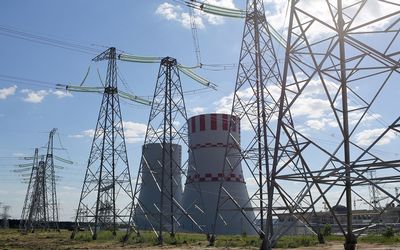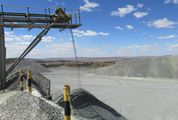Eskom’s improved outlook not about skill but rather SA’s economic slowdown
by Paul Burkhardt and Franz Wild,
2016-03-14 11:31:24.0
AFTER power cuts that crippled economic growth, SA has kept the lights on for more than six months and outages may not return in the next few years. But the improved outlook is less about what the state power utility is doing and more to do with an economic slowdown.
A rout in metals prices has hurt mining and lower global demand has curbed manufacturing, which together make up 20% of the gross domestic product (GDP) of Africa’s most industrialised country. While less demand keeps supply consistent, it exacerbates the financial issues faced by Eskom.
The utility’s borrowing costs have increased and the government has buoyed the company with cash injections.
"The issue isn’t that Eskom has magically turned around — the issue is that demand has fundamentally collapsed," said Shaun Nel, a spokesman for the Energy Intensive Users Group of SA, which represents 31 of the country’s largest electricity consumers including Sasol and Anglo American Platinum. "If the commodities situation remains for next year as well, then we’ll see the likelihood of power cuts next year significantly diminished as well."
Power generated by Eskom’s plants fell to the lowest since 2006 last year, the utility said in a fact sheet on its website. Still, revenue has increased every year since then as the national energy regulator allowed the company to raise prices by an average 16% annually, or more than double the mean inflation rate of 6.1% over the 10-year period. Despite this, its cash needs have climbed as it needs R237bn in additional finance in the five years to 2019.
Yields on Eskom’s dollar-denominated bonds due in January 2021 have climbed more than 300 basis points since the start of 2015 to 8.81%.
"We have seen a drop in terms of demand, but it’s not drastic," Eskom spokesman Khulu Phasiwe said in an interview. "There may be a drop in terms of demand in the mining sector," but that is largely compensated through purchases by neighbouring countries, he said.
Eskom has agreed to sell power to Zambia and Zimbabwe, both of which suffer electricity shortages. They are discretionary deals that can be downsized if SA’s grid becomes constrained.
Eskom CEO Brian Molefe plans to deliver new generation units after years of delays from planning problems, labour issues and quality control. He also implemented a maintenance programme last year designed to reduce power cuts and conduct needed repairs at the utility’s existing facilities.
"There has been some improvement in the unplanned losses," Mr Nel said.
The utility will be forced to improve savings and reduce the amount it spends on coal, used to generate about 80% of its power, after the energy regulator capped an electricity-price increase for the coming year to an average 9.4%, Fitch Ratings analysts said in a March 3 note. The agency assumed Eskom would be allowed an increase of about 12%.
Mines are Eskom’s third-biggest customer group, accounting for 14% of total sales, following 25% for industrial users and 42% by municipalities, data on the utility’s website showed.
Electricity has been the fastest-growing component of the mining industry’s cost base and has increased more than fourfold over the past seven years, Chamber of Mines CEO Roger Baxter said on March 1. "Further pressure on electricity prices will push a number of mining companies further into the red, necessitating further restructuring."
While Eskom sees surplus power in five years after new generation units are completed, lower consumption because of higher prices will occur on a wider scale, Anton Eberhard, a professor at the University of Cape Town’s Graduate School of Business, said.
"SA is becoming more energy-efficient, economic growth is tepid, and consumers will start defecting from the grid," he said. "Future price determination by the regulator will compensate for lost revenue through higher price increases, but this will lead to less electricity consumption — a vicious circle."
Bloomberg

Picture: BLOOMBERG
AFTER power cuts that crippled economic growth, SA has kept the lights on for more than six months and outages may not return in the next few years. But the improved outlook is less about what the state power utility is doing and more to do with an economic slowdown.
A rout in metals prices has hurt mining and lower global demand has curbed manufacturing, which together make up 20% of the gross domestic product (GDP) of Africa’s most industrialised country. While less demand keeps supply consistent, it exacerbates the financial issues faced by Eskom.
The utility’s borrowing costs have increased and the government has buoyed the company with cash injections.
"The issue isn’t that Eskom has magically turned around — the issue is that demand has fundamentally collapsed," said Shaun Nel, a spokesman for the Energy Intensive Users Group of SA, which represents 31 of the country’s largest electricity consumers including Sasol and Anglo American Platinum. "If the commodities situation remains for next year as well, then we’ll see the likelihood of power cuts next year significantly diminished as well."
Power generated by Eskom’s plants fell to the lowest since 2006 last year, the utility said in a fact sheet on its website. Still, revenue has increased every year since then as the national energy regulator allowed the company to raise prices by an average 16% annually, or more than double the mean inflation rate of 6.1% over the 10-year period. Despite this, its cash needs have climbed as it needs R237bn in additional finance in the five years to 2019.
Yields on Eskom’s dollar-denominated bonds due in January 2021 have climbed more than 300 basis points since the start of 2015 to 8.81%.
"We have seen a drop in terms of demand, but it’s not drastic," Eskom spokesman Khulu Phasiwe said in an interview. "There may be a drop in terms of demand in the mining sector," but that is largely compensated through purchases by neighbouring countries, he said.
Eskom has agreed to sell power to Zambia and Zimbabwe, both of which suffer electricity shortages. They are discretionary deals that can be downsized if SA’s grid becomes constrained.
Eskom CEO Brian Molefe plans to deliver new generation units after years of delays from planning problems, labour issues and quality control. He also implemented a maintenance programme last year designed to reduce power cuts and conduct needed repairs at the utility’s existing facilities.
"There has been some improvement in the unplanned losses," Mr Nel said.
The utility will be forced to improve savings and reduce the amount it spends on coal, used to generate about 80% of its power, after the energy regulator capped an electricity-price increase for the coming year to an average 9.4%, Fitch Ratings analysts said in a March 3 note. The agency assumed Eskom would be allowed an increase of about 12%.
Mines are Eskom’s third-biggest customer group, accounting for 14% of total sales, following 25% for industrial users and 42% by municipalities, data on the utility’s website showed.
Electricity has been the fastest-growing component of the mining industry’s cost base and has increased more than fourfold over the past seven years, Chamber of Mines CEO Roger Baxter said on March 1. "Further pressure on electricity prices will push a number of mining companies further into the red, necessitating further restructuring."
While Eskom sees surplus power in five years after new generation units are completed, lower consumption because of higher prices will occur on a wider scale, Anton Eberhard, a professor at the University of Cape Town’s Graduate School of Business, said.
"SA is becoming more energy-efficient, economic growth is tepid, and consumers will start defecting from the grid," he said. "Future price determination by the regulator will compensate for lost revenue through higher price increases, but this will lead to less electricity consumption — a vicious circle."
Bloomberg



























Change: 0.83%
Change: 0.93%
Change: 0.95%
Change: 0.73%
Change: 1.91%
Data supplied by Profile Data
Change: 0.58%
Change: -0.15%
Change: 0.83%
Change: 0.00%
Change: -0.13%
Data supplied by Profile Data
Change: 0.49%
Change: 0.18%
Change: 0.28%
Change: 0.14%
Change: 0.24%
Data supplied by Profile Data
Change: -0.22%
Change: -0.21%
Change: -0.26%
Change: 1.41%
Change: 3.03%
Data supplied by Profile Data